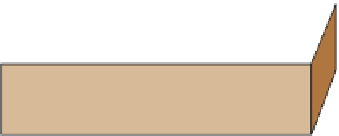Geoscience Reference
In-Depth Information
To see the relationship of earthquakes and plate boundaries,
look at Figure 13.7a, which shows the plate movements along a
transform margin. The important thing to remember is that these
plates do not slide by one another gradually. Instead, these oppos-
ing masses of rock are locked by friction for long periods of time,
causing elastic stress to build on both sides of the fault. This stress
builds to a critical point when a rupture occurs along the fault plane.
The stress released is somewhat analogous to the stress instantly
released in a stretched rubber band when it is cut, causing the rock
layers on either side of the fault immediately to adjust. The place
within the lithosphere where the fault breaks is called the
focus
and
usually occurs a few kilometers deep within the ground (Figure
13.17). In California, for example, the average focal depth is be-
tween 6.4 km and 9.5 km (4 mi to 6 mi). The point on the surface
directly above the focus is known as the
epicenter
. When the rocks
finally break free of each other, they do so in an abrupt movement
and release powerful seismic waves into the surrounding crust.
Epicenter
Fault
Seismic
waves
Focus
Figure 13.17 Schematic diagram of earthquake processes.
Earthquakes occur when tension is abruptly released along a
fault, causing opposing rock bodies or plates to move in oppo-
site directions relative to one another. This movement generates
seismic waves that radiate through the crust. Uplift along a fault
can result in a distinct cliff or bluff along a fault, known as a fault
scarp. The motion of plates that causes an earthquake can come
from stress buildup associated with a transform fault, subduction,
and collision.
Locating the Epicenter
When an earthquake occurs, the first
goal of geologists is to determine the location of the epicenter.
This search is accomplished through the process of triangulation,
in which the distance to the epicenter is compared among seis-
mographs stationed at three separate locations. This methodology
is based on the fact that earthquakes produce two kinds of seis-
mic waves, or
body waves
, that radiate through the Earth's inte-
rior. These body waves consist of
P waves
(or
primary waves
) and
S waves
(or
secondary waves
) that move in different ways and travel
at different speeds. P waves are compressional waves that cause the
Earth's crust to expand and contract rapidly in a horizontal man-
ner as the waves radiate out from the epicenter. P waves typically
move at about 1.5 km to 8 km (~1 mi to 5 mi) per second through
the crust. S waves, however, move about 60% to 70% slower than
P waves and shake the ground in a vertical fashion that is similar
to sending a wave pulse along a rope or string when you whip it up
and down. In an earthquake, S waves cause the ground to vibrate in
a rolling fashion that can be quite noticeable and frightening. The
magnitude of both these waves is measured at observation stations
with a device called a seismograph (Figure 13.18).
Epicenter
The point on the Earth's surface that lies directly
over the focus of an earthquake.
Wire
Support
Support
Rotating
cylinder
Spring
Pen
Large
mass
Large
mass
Rotating
cylinder
Pen
Vertical
motion
of Earth
Horizontal motion
of Earth
(a)
(b)
Figure 13.18 Measuring seismic waves.
Seismic waves associated with an earthquake are
measured with a seismograph. When the Earth shakes, a platform moves back and forth beneath
a stationary pen that records the movement on a continuous roll of paper. (a) Primary waves
(P waves) consist of compressional waves that cause vibrations parallel to their travel direction.
(b) In contrast, secondary waves (S waves) cause vertical vibrations to develop. P waves move
more quickly than S waves and are thus the first to be felt.


























































































